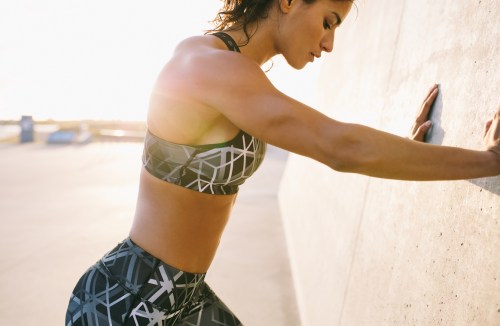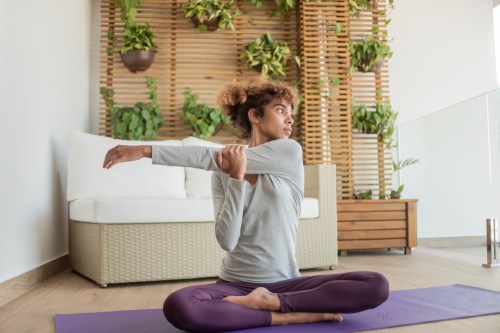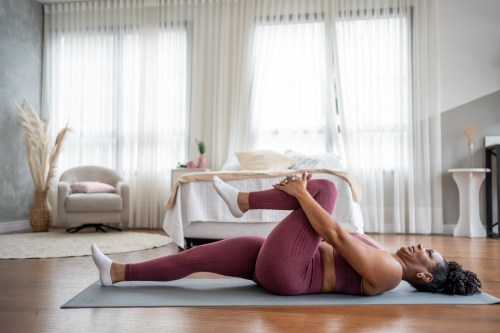These 8 Stretches Can Melt Away the Most Common Muscle Aches
Aching muscles can feel debilitating. Here, find eight deep stretches for muscle soreness, plus trainer insights on how often to stretch.

Aching muscles that have become a cornerstone of so many of our days. While muscle soreness can sometimes be a sign of accomplishing a challenging workout, other times, it can be the result of living a stationary life. In either event, living with aching muscles is anything but ideal—let alone comfortable.
Experts in This Article
vice president of education at StretchLab
founder &
podiatrist and member of the Vionic Innovation Lab
integrative nutrition health coach and certified exercise physiologist.
creator of Physique 57
Well+Good is always collecting stretches for aching muscles, and here, we now present you with the best of the best.
Whether you have IT band tightness from running, need a stretch to help soothe your period cramps, or dream of alleviating the pinching in your lower back from incessantly sitting with poor posture while working from the couch, we’ve got something for you. Ahead, find eight deep stretches and muscle flexibility exercises to offer some relief into your routine.
But first, what are the benefits of stretching?
Stretching is a versatile exercise modality that can offer both pre- and post-workout support, as well as relief from everyday activities and postures that have nothing to do with sweating your heart out. “Stretching offers several benefits for the body and mind, including improved flexibility, increased range of motion, enhanced circulation, stress reduction, and injury prevention,” says fitness expert Tanya Becker, who is the co-founder of Physique 57 Method. Specifically, Becker says that stretching:
- Improves flexibility and range of motion by elongating and relaxing muscles, tendons, and connective tissues. As Becker points out, improved flexibility directly correlates to better mobility and less stiffness. “Improved flexibility can help you perform everyday activities with more ease and grace,” she says.
- Enhances blood circulation to the muscles and throughout the body. This is key, as adequately oxygenated muscles are less likely to experience tension and fatigue.
- Reduces muscle tension. “Stretching helps relieve muscle tension, which can build up from daily activities, sedentary behavior, or stress,” Becker explains. “It’s like having a cup of chamomile for your muscles.”
- Improves posture. Muscular imbalances from working in less-than-ergonomic setups are common, Becker assures us. “Regular stretching can assist in correcting these imbalances by lengthening tight muscles that may be contributing to poor posture,” she says. “This can lead to improved alignment and reduced strain on the muscles and joints, so you can walk through life with more ease and comfort.”
- Relieves and helps manage pain. If you’re like me (i.e. someone with chronic neck and shoulder pain), Becker says that stretching can be a godsend. “Stretching can alleviate muscle pain and discomfort, especially if it’s related to muscle tightness or tension,” she says. (Just be sure to avoid common stretching mistakes so you don’t accidentally cause more pain.)
- Prevents injury. The more relaxed and malleable your muscles are, the less likely they are to snag mid-movement, Becker points out. “Regular stretching can help prevent injuries by improving muscle flexibility,” she explains. “It prepares the body for physical activities and reduces the risk of strains, sprains, and other injuries.”
8 stretches for aching muscles that you’re going to want to bookmark
1. For outer thigh tightness: standing TFL stretch
If your outer thighs are aching, it’s likely because you have a tight IT band, Austin Martinez, CSCS, director of education for StretchLab, previously told Well+Good. Because you can’t stretch the IT band itself, you’ll need to loosen the muscles around it instead. Start with your tensor fascia latae (or TFL), the muscle that connects to the gluteus maximus and runs parallel to the IT band. To stretch it, stand up and cross your right ankle behind your left ankle. Bend through your left knee, and push your right hip out to the right, holding on to a table or wall to stabilize yourself. Hold the stretch for 20 to 30 seconds and repeat on the left side.
2. For constipation: happy baby
When things aren’t going the way you want them to in the old GI tract, you’ll try just about anything—right? We asked a few pelvic floor experts to tell us which poses will help you get things moving, and happy baby was on that list.
If you’re unfamiliar with this common yoga pose or “asana” (called ananda balasana in Sanskrit), you can get into happy baby by lying on your back and doing the following: Bend your knees toward your chest with the soles of your feet facing the ceiling. Your knees should be at about a 90-degree angle. Use your hands to grab your feet or big toes. Bring your knees wide toward your armpits, and gently rock from side to side. Breathe.
3. For foot pain: downward dog
Jackie Sutera, DPM, a podiatrist with Vionic Labs, blew our minds when she told us that foot pain tends to originate from the calf muscles. “I would argue that calf stretches are the most important for the overall foot,” she says. “This will lengthen and loosen both the Achilles and plantar fascia—two very important structures that will cause inability to walk properly and pain if there is a problem.” With that said, she told us that yoga’s downward dog pose (adho mukha shvanasana in Sanskrit) is one of the best stretches for these tricky muscles.
To try downward dog, come to your hands and knees and tuck your toes. Push through your heels to lift your hips, straighten your legs, and point your tailbone to the sky. Gently push your heels toward the ground to really feel the magic of the calf stretch, and slightly bend your knees if your hamstrings are tight.
Here’s the right way to downward dog:
4. For achey desk hips: warrior I
If you spend most days sitting, your hips are probably screaming by 5 p.m. To help them out (and ensure you get up from your desk at least once today), stand up for Warrior I pose (virabhadrasana I in Sanskrit; aka the ultimate after-work stretch).
Place your right foot forward and your left foot back, bringing your feet as wide as your hips for stabilization. Bend your front knee while leaving your back leg straight. Stretch your arms up to the ceiling and hold for 20 seconds then switch sides. Beware: Warrior I is definitely not an easy stretch, but it’s an effective one.
5. For facial tension: thumb slides
Raise your hand if you hold a lot of tension in your jaw. Wow, there are so many of us! Luckily, Inge Theron, founder of FaceGym, has a simple exercise you can do when it starts to feel like the weight of the world is resting on your cheeks. First, apply a facial oil to your skin. Then, slide your thumbs from the top of your nose, across your eyebrows, and onto your temples. Draw three circles onto your temples. Then repeat the move three to five times.
6. For your low back: the pillow stretch
No stretch called “the pillow stretch” could be bad, but this one’s extra yummy. Place two pillows under your pelvis at the end of a bed, and lie on top, hanging your upper body off the edge. Take 10 deep breaths (or more) in this position and feel the tension melt away from your lower back.
7. For menstrual cramps: the Double Knee Hugg*r
You know how having your period can make you want to curl up into a ball? Well, the Double Knee Hugg*r stretch is basically a way of doing that. Instead of turning on your side, lie down on your back and bring your knees into your chest, clutching your hands behind the backs of your knees. Close your eyes and enjoy the stretch. This move also targets your lower back, hamstrings, and glutes to bring relief to the whole general area that may be suffering from period pain.
8. For tight shoulders: child’s pose arm lift
“If you’re tight in your thoracic spine [upper back], it probably means you’re weak in that area too,” Shelby Smith, a personal trainer based in Rhode Island, previously told Well+Good about shoulder mobility. “So you’ll want to pair stretching moves with strengthening moves.” Child’s pose (balasana in Sanskrit) is usually about as chill of a stretch as they come, but Smith’s variation makes sure you sneak in the strengthening, too.
Ready? Start in child’s pose lying your upper body on your knees with your hips pressing toward your feet. Extend your arms forward and turn your palms to face each other so that your thumbs are pointed up to the sky. Slowly raise and lower one arm at a time. Complete this move for 30 to 60 seconds.
How often should you stretch?
How often you incorporate deep and static stretches into your daily and weekly routine depends on your own personal preferences and goals. That said, Becker has some general guidelines to lead you in the right direction:
Stretch daily
Whether you work out or not, Becker says that incorporating some form of stretching into your daily routine can improve your overall quality of life, as it will alleviate aching muscles and provide relief for areas of tightness and tension. “Light stretching in the morning or before bed can be beneficial for promoting flexibility and reducing muscle stiffness,” she says.
Reserve dynamic stretches for before your workout
As tedious as it may seem to spend five to 10 minutes before each workout simply preparing your muscles for it, Becker emphasizes that doing so can actually make you perform better during your routine. “Dynamic stretching involves moving the muscles and joints through their full range of motion,” she explains.
Enjoy static stretches after working out
Where dynamic stretches are in motion, static stretches are deep stretches that you hold in place. According to Becker, static stretches should be focused on major muscle groups and should be held for 15 to 60 seconds each, and performed a few times over thereafter. “After your workout or physical activity, perform static stretching to help cool down and relax your muscles,” she says.
Can stretching prevent aching muscles?
Remember: When you stretch dynamically, you warm up your muscles, which can prevent them from getting injured mid-workout. It’s not just about avoiding injury, though. Pre-workout (and post-workout) stretching elongates muscles, diminishes tension, and ultimately soothes muscles so that they don’t stay tight and contracted for days on end, leading to late muscle soreness.
“Stretching can be an effective tool to help prevent or alleviate aching muscles, especially when done as part of a warm-up before physical activity or as a cooldown after exercising,” Becker says. “This is because stretching helps increase blood flow to the muscles, which improves circulation and nutrient delivery. In addition, stretching helps relax muscles by releasing tension and tightness. When muscles are relaxed, they are less likely to become sore or ache after physical activity.”
It can also be a smart part of your post-workout recovery routine. “Stretching can help relax and relieve muscle tension, which often builds up during physical activity,” says Becker. But, she adds, “other factors such as proper hydration, adequate nutrition, rest, and gradual progression in physical activity are equally important in the recovery process.”
What precautions should you take while stretching?
Stretching is highly beneficial when done correctly. Notice that last part. Because of this, Becker says that taking certain precautions while stretching is necessary:
Warm-up
While stretching is often thought to be the best first course of action during a workout, Becker says that it should actually be performed after a light aerobic warm-up, like jogging or jumping jacks. “Cold muscles are more prone to injury, so warming up increases blood flow and prepares the muscles for stretching,” she explains.
Use the proper technique
“Avoid sudden, jerky motions or bouncing, as this can cause muscle tears or strain,” Becker warns. Instead, she recommends gentle and controlled movements to get your muscles in gear.
Avoid pain
When stretching, you want to stretch—not injure—your muscles. “Stretch to the point of mild discomfort or tension, never to the point of pain,” Becker says. “Pain during stretching may indicate that you are stretching too aggressively or possibly injuring yourself.”
Breathe and relax
When reaching for a deep stretch, it’s common to accidentally hold your breath. Becker says not to. “Maintain steady breathing and stay relaxed throughout each stretch,” she counters. “Holding your breath during stretching can lead to muscle tension and increased blood pressure.”
Progress gradually
As tempting as it may be to reach for a deep stretch you saw a yogi execute on Instagram, be mindful of your own capabilities. “Start with gentle stretches and progress gradually over time,” she suggests. “Avoid forcing your body into positions that are too difficult or uncomfortable. Consistency and gradual progression are key.”
Some signs that you’ve overstretched include sharp or sudden pain, intense discomfort or a burning sensation, a decreased range of motion, swelling or inflammation, muscle weakness or fatigue, bruising, tenderness, a prolonged recovery time, or an audible pop (which is never a good thing). In all of these instances, it’s best to give your body time to recover. If you’re experiencing long-lasting pain or discomfort, though, you may want to reach out to a doctor to assess the best next steps.
Is it better to rest or stretch when you have sore muscles?
Becker says that both rest and stretching are essential for alleviating aching muscles. “Their effectiveness depends on the timing and context of your soreness,” she says.
For example, after an intense workout—especially if you’re incredibly sore—rest is the proper route to take. “Resting allows your muscles to repair and rebuild,” Becker says. “For instance, give your muscles time to recover by allowing at least 24 to 48 hours of rest before engaging in similar intense activities. During this time, focus on adequate hydration, nutrition, and sleep to support the recovery process.” That’s not to say you can’t stretch or move your body during that timeframe—just take it easy with lower-intensity workouts like walking, swimming, yoga, or cycling, “which can promote blood circulation and help alleviate muscle soreness without causing additional strain,” she says.
Meanwhile, if your legs are sore and shaking after an intense lower body workout—but not so much so that you feel immobilized—stretching will help your muscles feel better while also prepping you for further exercise in the days to come.
All in all, Becker says you have to listen to your body when determining when to stretch, which stretches to opt for, and how often to perform them. One thing’s for sure, though: Stretching is almost always a good idea.
Sign Up for Our Daily Newsletter
Get all the latest in wellness, trends, food, fitness, beauty, and more delivered right to your inbox.
Got it, you've been added to our email list.










